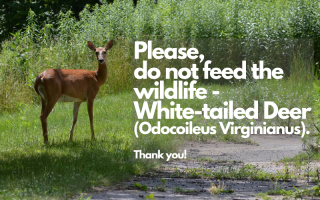Feeding of Wildlife & White-Tailed Deer Prohibited
Posted on: July 13, 2022 - 11:56am

As expressed in Chapter 3-14 of the Borough Code "Feeding of Unconfined Wildlife" https://ecode360.com/34942863, the feeding of wildlife is prohibited in Midland Park. No person shall feed, in any public park, on any other property owned or operated by the Borough of Midland Park, or any private property, any wildlife (with the exception of bird feeders).
Similarly, the NJ DEP Divison of Fish & Wildlife advises against feeding wildlife, especially the white-tailed deer. Feeding of wild deer is undesirable because:
- Feeding increases reproductive potential.
- Deer with higher nutrition levels have larger litter sizes and breed earlier. Does dependent solely upon natural food sources generally breed at 1.5 years of age and give birth to a single fawn. Does with supplemental food breed at 6 months of age and give birth to one fawn; 1.5 year olds generally have twins, and triplets are not uncommon in older does.
- Deer lose their fear of humans.
- In NJ, deer are considered a "potentially dangerous species" because of their ability to inflict serious physical harm to humans with their hooves and antlers. Male deer become more aggressive during the breeding season, and females may become defensive of their fawns. The last reported attack of a deer on a person was in 2012 in Lake Hopatcong, NJ. Deer that become problematic are usually euthanized.
- Feeding enhances the spread of disease and parasites, and may compromise the health of non-target species.
- Concentrating deer in unnaturally high numbers around food piles increases nose-to-nose contact and may heighten the transmission of pathogens and parasites. Additionally, large piles of supplemental foods like corn often develop toxic fungi, which cause ill effects to both deer and other animals that come to the food pile.
- Deer feeders are bad neighbors.
- Deer cannot meet all their nutritional needs from a food pile, and will consume the plantings of surrounding properties or devastate the surrounding natural environment after the supplemental food is consumed. Because feeding concentrates deer in unnaturally high numbers, environmental damage is often severe.
- Feeding can change behavioral patterns.
- Feeding may cause deer to cross roadways they normally would not, increasing the potential for deer-vehicle collisions.
- Feeding can sicken and kill deer.
- Deer, like most animals, have symbiotic microorganisms in their digestive system which enable them to break down the cellulose found in plant matter. As the seasons slowly change from one to another, so too do these organisms change to accommodate the change in available natural foods. When deer are fed high carbohydrate foods out of season they lack the necessary gut microflora to digest these foods. This can result in a condition known as lactic acidosis, which causes bloating, diarrhea, enteritis, and in some cases, death.
Click here: NJDEP Division of Fish & Wildlife - Feeding Deer in Winter (state.nj.us) to read more from the NJ DEP Division of Fish & Wildlife.

